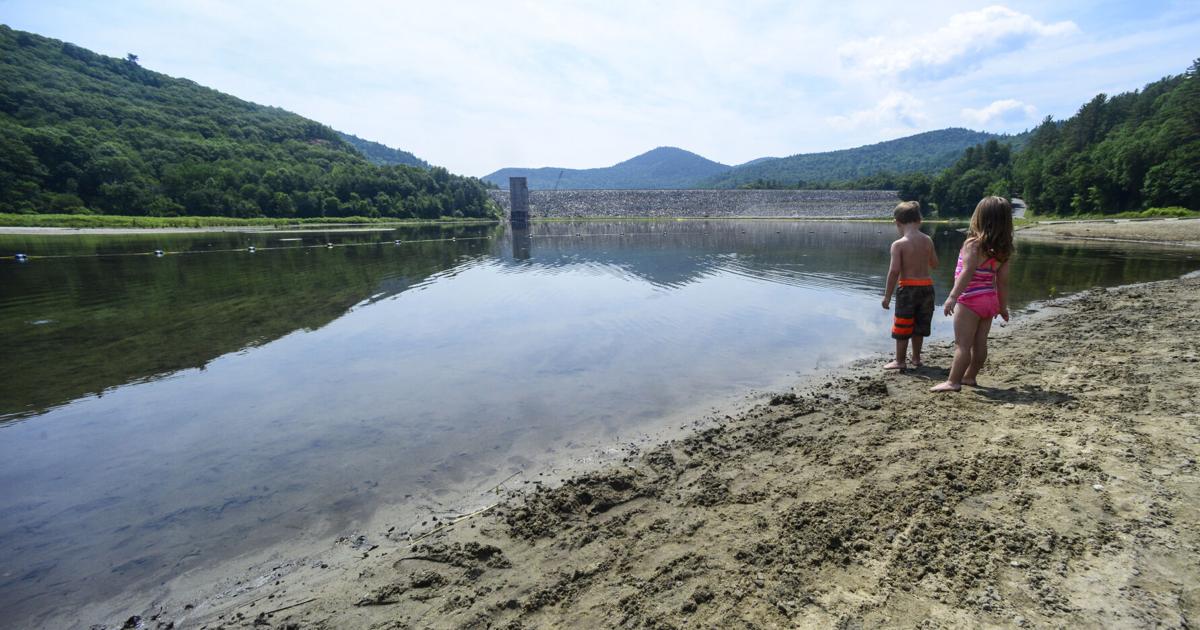News
Jamaica and Townshend Dams at Risk of Overflow, Warns U.S. Army Corps of Engineers

Table of Contents
Introduction
The U.S. Army Corps of Engineers has recently issued a prediction that the Jamaica and Townshend dams in the United States could potentially overflow due to the increased water levels in their respective reservoirs. This prediction has raised concerns among local communities and authorities who rely on these dams for various purposes, including flood control and water supply. In this article, we will delve into the details of the situation, exploring the reasons behind the predicted overflow and its potential implications.

1. Overview of Jamaica Dam
Jamaica Dam is a significant water infrastructure project located in the heart of the United States. It was constructed several decades ago to serve multiple purposes, including flood control, water storage, and hydroelectric power generation. The dam stands tall, holding back millions of gallons of water in its reservoir.
2. Challenges Faced by Jamaica Dam
Over the years, Jamaica Dam has encountered various challenges. The ageing infrastructure, coupled with the increasing frequency of extreme weather events, has put immense pressure on the dam’s capacity. Heavy rainfall, prolonged periods of precipitation, and rapid snowmelt have significantly contributed to the rising water levels in the reservoir.
3. The Importance of Townshend Dam
Adjacent to Jamaica Dam is the Townshend Dam, another crucial water management structure. It serves as a complementary reservoir, supporting the functions of the Jamaica Dam. Together, these dams form a vital part of the regional water management system, providing water supply to communities, controlling floods, and supporting ecological stability.
4. Factors Contributing to Potential Overflow
Several factors have contributed to the U.S. Army Corps of Engineers’ prediction of potential dam overflow. First and foremost is the increased water inflow due to heavy precipitation. The region has experienced above-average rainfall in recent months, resulting in a significant rise in the water levels of both dams’ reservoirs.
Additionally, the ageing infrastructure of the dams and their limited capacity to handle extreme weather events have further escalated the risk of overflow. The accumulation of sediment over the years has reduced the reservoir’s capacity to store water, making it more susceptible to reaching its maximum limit.
5. Impact on Local Communities
The potential overflow of the Jamaica and Townshend dams could have severe consequences for the local communities in the vicinity. One primary concern is the increased risk of flooding. If the dams were to overflow, the excess water could inundate nearby areas, leading to property damage, infrastructure disruptions, and potential threats to human lives.
Moreover, these dams are crucial for supplying water to the surrounding communities. In the event of an overflow, water availability could be severely impacted, leading to shortages and potential disruptions in various sectors, such as agriculture, industry, and domestic use.
6. Precautionary Measures Taken
Recognizing the seriousness of the situation, local authorities and the U.S. Army Corps of Engineers have taken immediate precautionary measures. Enhanced monitoring systems have been deployed to closely track water levels, weather patterns, and the overall condition of the dams. This proactive approach allows for early detection of any potential issues and enables prompt action to mitigate the risks.
7. Emergency Response Plans
In anticipation of a potential dam overflow, comprehensive emergency response plans have been put in place. These plans outline the necessary steps to be taken in the event of an emergency, including evacuation procedures, coordination with local authorities, and communication strategies to keep the public informed and safe.
8. Efforts to Prevent Overflow
To prevent the predicted overflow, various efforts are underway. The U.S. Army Corps of Engineers is working diligently to manage the water levels by implementing controlled releases from the reservoirs. This strategy aims to reduce the water volume and alleviate the pressure on the dams, decreasing the likelihood of overflow.
Furthermore, maintenance and rehabilitation projects have been initiated to address the aging infrastructure issues. These projects involve sediment removal, structural repairs, and capacity enhancement to ensure the long-term resilience of the dams.
9. Environmental Considerations
While addressing the potential dam overflow, it is crucial to consider the environmental impact of the mitigation measures. Environmental experts and organizations are actively involved in the decision-making process, ensuring that the actions taken do not harm the local ecosystems and biodiversity. Balancing the need for public safety with environmental stewardship remains a key priority.
10. Public Safety Measures
Public safety is of paramount importance during this critical period. Local communities have been advised to stay informed about the situation through official channels and follow any evacuation orders or safety guidelines issued by authorities. It is crucial to remain vigilant and prepared for any potential emergency.
11. Long-term Solutions
Addressing the challenges faced by the Jamaica and Townshend dams requires long-term solutions. The U.S. Army Corps of Engineers is actively exploring options to improve the dams’ resilience, including potential infrastructure upgrades, capacity expansions, and enhanced flood control measures. These long-term solutions aim to ensure the sustainable management of water resources and the long-term safety of the communities.
12. Collaborative Approach
Managing the potential dam overflow necessitates a collaborative approach involving various stakeholders. Local authorities, the U.S. Army Corps of Engineers, environmental organizations, and community representatives are working together to develop comprehensive strategies and action plans. This collaborative effort strengthens the decision-making process and fosters a shared sense of responsibility.
13. Future Dam Management
The challenges faced by the Jamaica and Townshend dams are not isolated incidents. Similar issues may arise in other dams across the country. Therefore, it is crucial to learn from these experiences and implement proactive measures in managing the nation’s dam infrastructure. By incorporating modern engineering techniques, regular maintenance, and effective risk assessment, the country can enhance its overall dam management practices.
14. Conclusion
The U.S. Army Corps of Engineers’ prediction of potential overflow in the Jamaica and Townshend dams serves as a wake-up call for the importance of proactive dam management. The combination of heavy precipitation, ageing infrastructure, and limited capacity has heightened the risk of dam overflow, potentially leading to flooding and water shortages in the affected communities. However, through collaborative efforts, precautionary measures, and long-term solutions, the potential risks can be mitigated, ensuring the safety and well-being of the communities relying on these vital water management structures.
FAQs (Frequently Asked Questions)
Q1: What are the primary functions of Jamaica Dam? Jamaica Dam serves the purposes of flood control, water storage, and hydroelectric power generation.
Q2: How is the potential overflow of the dams predicted? The U.S. Army Corps of Engineers uses advanced monitoring systems to track water levels, weather patterns, and dam conditions to predict potential overflow.
Q3: What are the potential consequences of dam overflow? The potential consequences include flooding, property damage, infrastructure disruptions, and water shortages in the surrounding communities.
Q4: What precautionary measures are being taken to address the situation? Enhanced monitoring systems, emergency response plans, and controlled releases of water from the reservoirs are among the precautionary measures being implemented.
Q5: Are there any long-term plans to improve dam resilience? Yes, the U.S. Army Corps of Engineers is exploring long-term solutions, such as infrastructure upgrades, capacity expansions, and improved flood control measures.
Discover more from The Monitor
Subscribe to get the latest posts sent to your email.
Corruption
Transparency International Pakistan releases NCPS 2025

ISLAMABAD—Transparency International Pakistan (TIP) on Tuesday released its comprehensive National Corruption Perception Survey (NCPS) 2025, presenting a mixed picture of public sentiment on corruption, anti-graft efforts, and governance across the country.
The survey, conducted with 4,000 respondents from all four provinces, reveals that while a significant majority of citizens did not report paying a bribe in the last year, three key public sectors—the Police, Tender/Procurement, and the Judiciary—continue to be perceived as the most corruption-prone institutions.
Table of Contents
Police Top List Despite Perception Improvement
According to the NCPS 2025 findings, the Police remains the most corrupt sector in the eyes of the public, cited by 24% of respondents nationwide. This is followed by the Tender and Procurement process at 16%, and the Judiciary at 14%.
However, the report highlighted a subtle but “notable” positive shift in public perception regarding the Police, registering a 6% improvement in perceived behaviour and service delivery compared to the previous survey.
Low Bribery Rate vs. High Dissatisfaction
The survey’s most encouraging statistic is that a majority of citizens (66%) reported they did not feel compelled to pay a bribe for public services in the past 12 months, which TIP considers a strong indicator of perceived progress in service delivery. Provincially, Sindh reported the highest rate of citizens encountering a demand for a bribe at 46%.
Despite the low rate of personal bribery, public satisfaction with the government’s overall efforts to combat corruption remains low. A significant 77% of respondents nationwide expressed “low satisfaction” or were “not satisfied” with the government’s anti-corruption drive.
The public identified the three major causes driving corruption as a lack of accountability (15%), lack of transparency and limited access to information (15%), and delays in the disposal of corruption cases (14%).
Demand for Accountability of Anti-Graft Bodies
The survey findings reflect a strong public demand for institutional reform and accountability. An overwhelming 78% of Pakistanis believe that anti-corruption institutions like the National Accountability Bureau (NAB) and the Federal Investigation Agency (FIA) should themselves be more accountable and transparent.
Citizens also proposed a blueprint for curbing corruption, prioritising:
- Enhancing accountability (26%)
- Limiting discretionary powers (23%)
- Strengthening Right to Information laws (20%)
The report also found a notable lack of awareness regarding reporting channels, with 70% of citizens being unaware of any official corruption reporting mechanism. Furthermore, 42% stated they would feel safe reporting corruption only if strong whistleblower protection laws were in place.
Economic Stability and Political Finance
On economic matters, approximately 58% of respondents indicated that the government has either fully or partially stabilised the economy, crediting the International Monetary Fund (IMF) programme and the country’s exit from the Financial Action Task Force (FATF) Grey List. However, 57% reported a decline in their purchasing power over the past year.
The survey also highlighted a strong public desire for clean electoral financing, with a combined 83% of respondents supporting either a complete ban or strict regulation of business funding to political parties.
In response to the report, Prime Minister Shehbaz Sharif welcomed the survey, stating that the large number of respondents who reported not encountering corruption during his government reflects the public’s recognition of the reforms aimed at transparency and economic recovery.
For more details on the survey’s public opinion findings, watch this report: Transparency International Report on Corruption – Public Opinion – 9 Dec 2025.
Discover more from The Monitor
Subscribe to get the latest posts sent to your email.
Entertainment
How Netflix Stole Warner Bros from David Ellison: Old Hollywood’s Miscalculation

For two decades, Netflix has been dismissed as a disruptor that would eventually plateau. Legacy Hollywood believed its dominance was temporary, a fad that would fade once the old guard flexed its muscle. Yet in 2025, the streaming pioneer pulled off a coup that stunned the industry: Netflix outmanoeuvred David Ellison’s Skydance and secured Warner Bros, rewriting the rules of entertainment economics.
Table of Contents
Macro Context: Streaming’s Rise and Hollywood’s Decline
The streaming wars have reshaped the global media landscape. Netflix, once a DVD‑by‑mail service, now commands billions in revenue and a subscriber base that dwarfs traditional cable. Meanwhile, legacy studios like Warner Bros Discovery struggled under debt, fragmented audiences, and outdated business models.
David Ellison’s Skydance, backed by ambition and capital, seemed poised to rescue Warner Bros. Yet Netflix’s strategic patience, global reach, and ability to monetise content across platforms proved decisive.
David Ellison’s Bid: Ambition Meets Reality
Ellison’s attempt to acquire Warner Bros was emblematic of Hollywood’s old guard—ambitious, well‑funded, but ultimately constrained by legacy thinking. Skydance’s merger talks with Paramount highlighted Ellison’s vision of building a modern studio empire. But when it came to Warner Bros, Netflix’s agility and scale proved insurmountable.
- Skydance Strategy: Focused on blockbuster franchises and traditional studio models.
- Netflix Strategy: Leveraged global subscriber data, AI‑driven content recommendations, and diversified revenue streams.
- Outcome: Ellison underestimated Netflix’s ability to play the long game.
Warner Bros: A Legacy Studio Recast
Warner Bros, once synonymous with Hollywood glamour, became a symbol of industry decline. Debt burdens, misaligned leadership, and fragmented IP portfolios left it vulnerable. Netflix’s acquisition was not just a business deal—it was a cultural takeover.
By absorbing Warner Bros, Netflix gained access to iconic franchises, a century of cinematic heritage, and a foothold in theatrical distribution. More importantly, it signaled that streaming had officially eclipsed legacy Hollywood.
Opinion: Why Old Hollywood Misread Netflix
As a senior columnist, I argue that Hollywood underestimated Netflix’s long game. For years, executives dismissed streaming as secondary to theatrical releases. They failed to grasp that Netflix was not just a content distributor—it was a data‑driven entertainment ecosystem.
Netflix’s ability to predict audience behavior, scale globally, and monetize IP across formats gave it an edge Ellison and others could not match. The Warner Bros deal is proof that the future belongs to platforms that combine technology with storytelling.
Conclusion
Netflix’s acquisition of Warner Bros is more than a headline—it’s a turning point. David Ellison’s failed bid underscores the limits of old‑guard Hollywood thinking. The lesson is clear: streaming is not the future, it is the present.
For policymakers, investors, and audiences, the message is unmistakable: Netflix didn’t just buy Warner Bros—it rewrote the rules of Hollywood.
Discover more from The Monitor
Subscribe to get the latest posts sent to your email.
Analysis
Folsom High School Football: More Than a Game, It’s an Economic Engine

High school football is often dismissed as a pastime, a Friday night ritual confined to bleachers and scoreboards. Yet in towns like Folsom, California, the sport has become a socioeconomic engine. Folsom High School football is not just about touchdowns—it’s about recruitment pipelines, local business growth, and the cultural identity of a community.
Table of Contents
Macro Context: The Business of High School Sports
Across the United States, high school athletics are evolving into a billion‑dollar ecosystem. Sponsorships, streaming rights, and recruitment networks are reshaping what was once purely extracurricular. For policymakers and business leaders, this shift demands attention: sports are no longer just about play, they are about economics.
Folsom High School football exemplifies this transformation. With a legacy of championships and a reputation as a California high school football powerhouse, the Bulldogs have become a case study in how athletics ripple into broader economic and cultural spheres.
Regional Insights: Folsom’s Legacy
The Bulldogs’ record speaks for itself: multiple state titles, nationally ranked players, and a program that consistently feeds talent into college football. But the legacy extends beyond the field.
- Recruitment Pipeline: Folsom’s roster has produced athletes who go on to Division I programs, drawing scouts and media attention.
- Community Identity: Friday night games are cultural events, uniting families, alumni, and local businesses.
- Media Reach: Coverage of the Bulldogs amplifies Folsom’s profile, positioning the town as a hub of athletic excellence.
Keywords like Folsom Bulldogs football schedule and Folsom football state championship history are not just search terms—they are markers of a program that commands attention.
Business & Community Impact
The economic footprint of Folsom football is undeniable. Local restaurants see surges in sales on game nights. Merchandising—from jerseys to branded gear—creates revenue streams. Sponsorships tie local businesses to the prestige of the Bulldogs, reinforcing community bonds.
Beyond dollars, the program fosters youth development. Student‑athletes learn discipline, teamwork, and resilience—skills that translate into workforce readiness. For parents and educators, the balance between academics and athletics is a constant negotiation, but one that underscores the broader value of sports.
Opinion: The Columnist’s Perspective
As a senior columnist, I argue that high school football is undervalued as an economic driver. Folsom proves that sports can shape workforce pipelines, community identity, and local business ecosystems.
The contrarian view is clear: policymakers and business leaders should treat high school athletics as strategic investments. Ignoring programs like Folsom’s risks overlooking a vital engine of socioeconomic growth.
While Wall Street debates interest rates and GDP, the real story of resilience and identity is unfolding under Friday night lights.
Conclusion
Folsom High School football is not just about wins—it’s about shaping California’s economy and culture. From recruitment pipelines to local business surges, the Bulldogs embody the intersection of sport and society.
The lesson is simple: sports are a mirror of our priorities and potential. And in Folsom, that reflection is bright, bold, and instructive for the nation.
Discover more from The Monitor
Subscribe to get the latest posts sent to your email.
-

 Featured5 years ago
Featured5 years agoThe Right-Wing Politics in United States & The Capitol Hill Mayhem
-

 News4 years ago
News4 years agoPrioritizing health & education most effective way to improve socio-economic status: President
-

 China5 years ago
China5 years agoCoronavirus Pandemic and Global Response
-

 Canada5 years ago
Canada5 years agoSocio-Economic Implications of Canadian Border Closure With U.S
-

 Conflict5 years ago
Conflict5 years agoKashmir Lockdown, UNGA & Thereafter
-

 Democracy4 years ago
Democracy4 years agoMissing You! SPSC
-

 Democracy4 years ago
Democracy4 years agoPresident Dr Arif Alvi Confers Civil Awards on Independence Day
-

 Digital5 years ago
Digital5 years agoPakistan Moves Closer to Train One Million Youth with Digital Skills




















